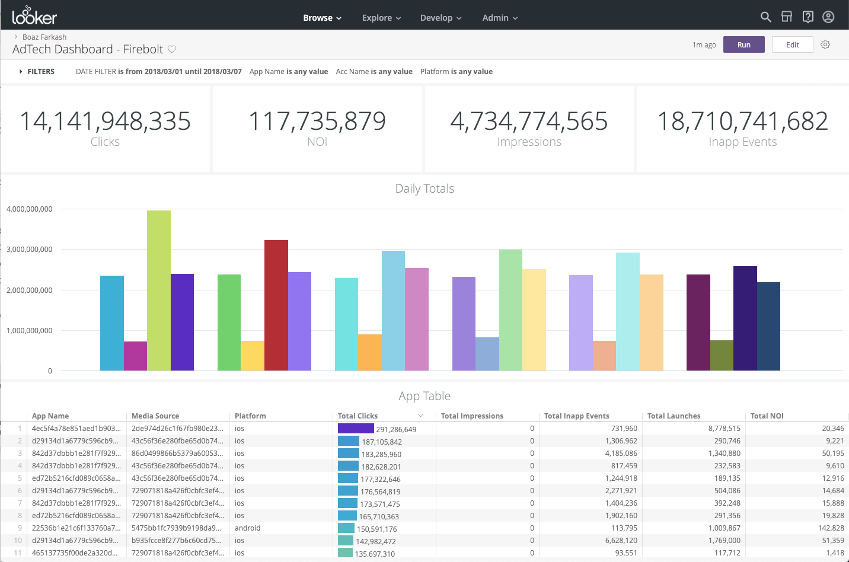Home
Product
Docs
Pricing
RESOURCES
company
Contact us
HANDS-ON WORKSHOP

Over the last few years, Appsflyer had pushed its internal analytics to the limit.
Three years ago, Appsflyer started using Looker. Over time, adoption grew to 1,000 Looker users across sales, support, marketing, finance, and HR, including 60 Looker experts who supported other users by building and maintaining the various dashboards.
Appsflyer was running their analytics on Amazon Athena, but as usage had grown, so had the challenges. First, the data had become too big for Athena to handle. Appsflyer has 35 petabytes of raw data about customers and their activities, with multiple tables consisting of billions to hundreds of billions of rows. Athena could not handle more than 5 billion rows of data in any query. So they had to aggregate the raw data using DataBricks to a smaller data set that Athena could handle. Athena also could not handle more than 20 concurrent queries, which had become a problem by the time Appsflyer reached 1,000 Looker users.
Second, the ETL process was slow, expensive, and inflexible to change. A spark job often took weeks to change, and days to run if they had to rebuild all the dimensions and history. This was not only too long, since users often required new reports in days, but also very expensive. Updates also became a problem with GDPR regulation. Each time an entity opted out, Appsflyer had to rerun entire Spark jobs to remove them, which not only took a long time to rerun. It cost them $20K each time as well.
Third, even with the dramatically reduced data sets, Athena was still too slow. Some queries took more than an hour to run. Most interactive analytics, such as the executive dashboards, required query times of a few seconds at most.
When the company needed a new report that required the detailed results from a join of two multi-billion row tables, Appsflyer decided it was time to replace Athena.

Appsflyer started to look at a cloud data warehouse that could store all of their data and aggregations, deliver the performance they needed, and provide greater self service so that various teams could deliver new analytics faster.
Appsflyer evaluated several vendors in a proof of concept (POC) with 3 stages: joining a big and small table, joining two big, multi-billion row tables, and a dashboard use case. They were already using BigQuery, and evaluated Snowflake, Vertica, Dremio, and SQream. They had evaluated Redshift a while ago and had ruled it out. They also used Druid with a customer Web interface for their customer-facing analytics and decided against using it because they needed a more general-purpose data warehouse.
In the end, they chose Firebolt based on its much faster performance, and much better price-performance. With Firebolt, all of Appsflyer’s 1,000 Looker users are now able to run any analytics, at any scale, in seconds, and deliver new reports within days.
As part of evaluating Firebolt, Appsflyer took the same schema and queries from Athena syntax and ran them on Firebolt, performing joins with 3 billion and 26 billion row tables.
Before Firebolt, any new data or schema needed to be processed using Spark. It could take weeks to develop and run the Spark jobs. With Firebolt, data engineers can now do most of the ELT in hours using 100% SQL, and run it in Firebolt at any scale. The first project took 2 weeks or so of development. Most work now takes a few days or less.

Performance was up to 183x from the benchmark from the start, even without tuning. During the POC, the smaller join on Firebolt, which had been taking at least 40-60 seconds using Athena, was under 5 seconds. Even the larger join, which could not be done on Athena, ran within 5 seconds after a little optimization. Now even the larger joins can be run in 1-2 seconds, and filtering is milliseconds.
When Appsflyer was using Athena, they could not analyze any data beyond 5 billion rows, which prevented them from performing a broad range of analyses and limited the time window of the analysis to 30 days. With Firebolt, there is no limit. Appsflyer is now able to analyze any level of detail, up to hundreds of billions of rows, with confidence. AppsFlyer also extended their reports to a full 12 month time window. Firebolt’s ability to scale horizontally also meant it easily supported any number of concurrent users.
With Athena, cost had not been as much of a concern; it just didn’t work at scale. But it was a major concern as they were evaluating their alternatives, in part because of their scale. BigQuery ended up being the other option they considered. Beyond Firebolt’s faster performance, it also ended up being up to 5x lower cost than the evaluated alternatives, in part due to its greater efficiency per node.
Before Firebolt, analytics at Appsflyer had been throttled by Athena’s limitations. With Firebolt, those limits are gone. With Firebolt, employees can now have interactive conversations with their data. They can use Looker to analyze data as they are trying to make decisions because everything in Looker now takes seconds or less.
As a result, customer service and other groups have already started to expand their use of Firebolt and Looker. This includes analyzing much larger data sets, including more granular data, and longer time periods.


With Firebolt, our 1000 Looker users can now run analytics against billions of rows and terabytes of data, in seconds or less.
Alexandra Sudilovski Senior BI Expert & Looker Guild Master, AppsFlyer